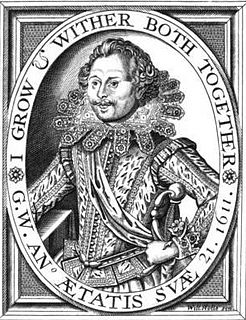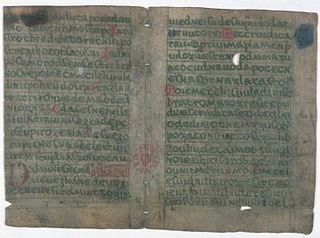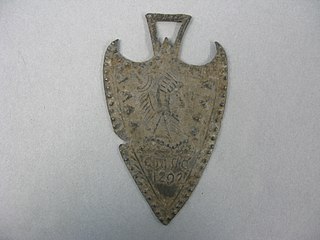Related Research Articles

Mary Baker was a noted impostor. Posing as the fictional Princess Caraboo, Baker pretended to come from a far off island kingdom. Baker fooled a British town for some months.

George Wither was a prolific English poet, pamphleteer, satirist and writer of hymns. Wither's long life spanned one of the most tumultuous periods in the history of England, during the reigns of Elizabeth I, James I, and Charles I, the Civil War, the Parliamentary period and the Restoration period.

John Doran was an English editor and miscellaneous writer of Irish parentage, wrote a number of works dealing with the lighter phases of manners, antiquities, and social history, often bearing punning titles, e.g., Table Traits with Something on Them (1854), and Knights and their Days. He edited Horace Walpole's Journal of the Reign of George III.. Among other posts, Doran was for a short time editor of The Athenaeum.

The Dvůr Králové and Zelená Hora manuscripts are literary hoaxes purporting to be epic Slavic manuscripts written in Old Czech. They first appeared in the early 19th century.
William Hals (1655–1737) was a British historian who compiled a History of Cornwall, the first work of any magnitude that was printed in Cornwall. He was born at Tresawsan, in the parish of Merther in Cornwall. Much of his work was never published but was used by other Cornish historians, including Davies Gilbert, Thomas Tonkin, and John Whitaker. Some of his original work is now held by the British Library.
Richard Herne Shepherd (1842–1895) was an English bibliographer.

Francis Stephen Cary was an English painter and art teacher, who succeeded Henry Sass as the head of his art academy. Among Cary's subjects was a portrait of Charles and Mary Lamb.
John Wheeley Gough Gutch (1809–1862) was a British surgeon and editor. He was also a keen amateur naturalist and geologist, and a pioneer photographer.
Henry Arthur Bright was an English merchant and author.
John Eagles (1783–1855), was an English artist and author. His essays, mainly in art criticism, appeared in Blackwood's Magazine and were collected and published after his death. He also produced poetry and translations.
Mackenzie Edward Charles Walcott (1821–1880) was an English clergyman, known as an ecclesiologist and antiquarian.

Joseph Austin Benwell (1816–1886) was an English artist, engraver and illustrator. He was primarily an artist in the 'orientalist' style. Many of his paintings and engravings were based on his travels in the Near and Middle East, China and India, often featuring camel caravans, Arab scenes and depictions of Indian life.

The Shadwell forgeries, also known as the Shadwell Dock forgeries or the Billy and Charley forgeries were a series of mid-19th century forgeries of medieval lead and lead-alloy artefacts. The latter name derives from the two Londoners, William (Billy) Smith and Charles (Charley) Eaton, who were responsible for their large-scale manufacture between 1857 and 1870. At the time, some antiquarians were fooled by the forgeries, despite them being crudely made by two individuals with limited skill in metalworking and little knowledge of medieval art.
John Mitford (1781–1859) was an English clergyman and man of letters.

Robert Aris Willmott was an English cleric and author. Christened Robert Eldridge Aris Willmott, he never used his second Christian name.
John Marckant or Markant was an English clergyman and author. He was the vicar of Great Clacton in Essex from 1559 until his death. But his fame rests on the claim that he was the author of several poems in The Whole Book of Psalms.

John Gregorson Campbell was a Scottish folklorist and Free Church minister at the Tiree and Coll parishes in Argyll, Scotland. An avid collector of traditional stories, he became Secretary to the Ossianic Society of Glasgow University in the mid-1850s. Ill health had prevented him taking up employment as a Minister when he was initially approved to preach by the Presbytery of Glasgow in 1858 and later after he was appointed to Tiree by the Duke of Argyll in 1861, parishioners objected to his manner of preaching.
John Nott (1751–1825) was an English physician and classical scholar.

John Lamb, was an academic and Anglican priest in the first half of the nineteenth century: a mathematician he was Master of Corpus Christi College, Cambridge from 1822 to 1837; and Dean of Bristol from 1837 until his death.

Poems on Various Subjects (1796) was the first collection by Samuel Taylor Coleridge, including also a few sonnets by Charles Lamb. A second edition in 1797 added many more poems by Lamb and by Charles Lloyd, and a third edition appeared in 1803 with Coleridge's works only. All three editions included poems in Coleridge's early Miltonic style, such as his Religious Musings and Monody on the Death of Chatterton, alongside lyrics and some of his first conversation poems, such as The Eolian Harp, in a style suggested by the works of William Cowper. The book was on the whole well received by reviewers; modern critics value it more for its shorter and lighter poems than for its formal set-pieces.
References
- ↑ Thomas Noon Talfourd, Final Memorials of Charles Lamb, i. 107-9; Fitzgerald, Life of Lamb, i. 392.
- ↑ Details of the more important items are given in the Gent. Mag. for 1861, Athenæum, 1858, i. 436, and in Notes and Queries , 2nd ser. v. 248, 268.
- ↑ See the 1861 census, reference RG9, piece 2109, folio 40, page 29.
- Attribution
- Kingsford, Charles Lethbridge (1890). . In Stephen, Leslie; Lee, Sidney (eds.). Dictionary of National Biography . Vol. 23. London: Smith, Elder & Co.
[Gent. Mag. 1829 ii. 556, 1830 i. 168, 1861 ii. 682-6, 1862 i. 792, ii. 112; Notes and Queries , 2nd ser. v. 248, 268, xii. 334, 5th ser. x. 204; Athenæum , 1858, i. 436, 500; Allibone's Dict. Engl. Lit. iii. 2807, col. i.; Brit. Mus. Cat.]